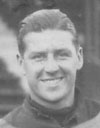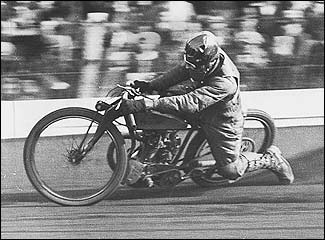|
Page updated
28-Dec-2010
|
Walter Hartley Phillips (1908 - 1998), known as Wal, was born in Tottenham, North London. He had a natural ability for things mechanical and by his early teens had put together a motorcycle from junk and spare parts. He wanted to be a race rider and financed his first ambitions by taking part-time jobs.
His uncle was a development engineer and works rider for JA Prestwich (JAP), the famous motorcycle engine manufacturer, and so Walter was able to talk his way into the competitors' enclosure at Brooklands by name-dropping. His first race was a handicap event and, taking the advice of the more seasoned racers, he made little effort in the first round. Finishing in the middle of the pack he was given a favourable handicap for the final. This enabled Wal to win the final by the proverbial country mile.
In 1928 the first dirt track meeting at High Beech saw Wal as one of the 30,000 spectators but he was not very impressed with the sport of speedway compared to the thrills of hammering around the Brooklands circuit. Fortunately for speedway, Wal was to go to another meeting. This was at Stamford Bridge where the American Lloyd 'Sprouts' Elder demonstrated the technique of 'broadsiding' under floodlight conditions. Wal recalled his first outing on the dirt track at Stamford Bridge (in the book Speedway Panorama by Ron Hoare) and remembered waiting in a café while watching the other riders arrive and warm up their engines. He was in no hurry as he had ridden to the circuit on his Scott, so it was already warm enough. He goes on to describe wonderful dices with Gus Kuhn, who had beaten him in a recent race at Crystal Palace. Though Gus just pipped him at the post in the final, the crowd roared for Wal to do a few exhibition laps. He fell off twice but the crowd were still roaring for him. And he remained a firm favourite. By the end of the season Wal was a record holder at Stamford Bridge and a key part of the team that won the Southern League championship when team racing was introduced into Britain in 1929. As one of the first home-grown riders to see off the Australians, he became a national hero and was part of the team picked for the first test against the Australians at Wimbledon in 1930. In 1932 Wal appeared in the Star Championship final and in 1936 he was to appear in the first World Championships at Wembley. Meanwhile, a speedway engine was being developed by Stan Greening of JAP. It had been met with a less than enthusiastic reception when tested by the Australian riders Billy Lamont and Vic Huxley but Greening was not going to be beaten - he borrowed Phillips' Rudge engine and stripped it down. He then built an engine incorporating the best of the Rudge and, naturally, some of his own ideas. The new JAP engine was fitted into a frame and shattered the record at Stamford Bridge. When Wal raced against Huxley at Harringay, Huxley could hardly believe his eyes. Such was the appeal of the engine that it remained a firm favourite with riders until the late 1960s. In 1933 both Wal and Gus moved to Wimbledon Speedway but unfortunately, in the 1936/7 season, Wal was to suffer a severe leg injury when racing in Australia. He then retired from racing and took over as the non-riding captain of Wimbledon for the 1939 season. He also wanted to become a qualified trainer, so Nobby Clark took him under his wing during the winter as his assistant at Harringay. Read more here. Wal remained an important figure in the sport for many years and was elected President of the Veteran Speedway Riders Association in 1968. Wal Phillips is now equally well known as the inventor of a fuel injection system for motorcycle and small automobile engines. The system was intended as a high performance replacement for the Amal carburettors and you can read more about it here: http://victorylibrary.com/brit/WP-c.htm For more info about Wal Phillip at Brooklands and Harringay click here: |

